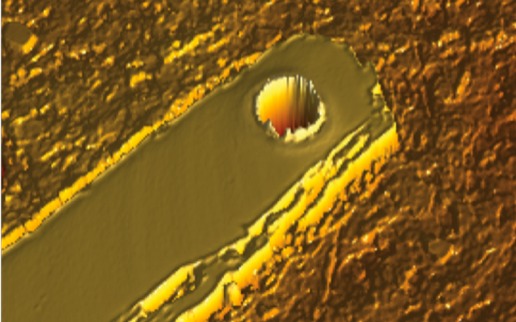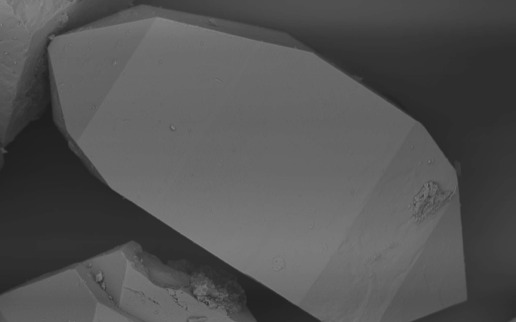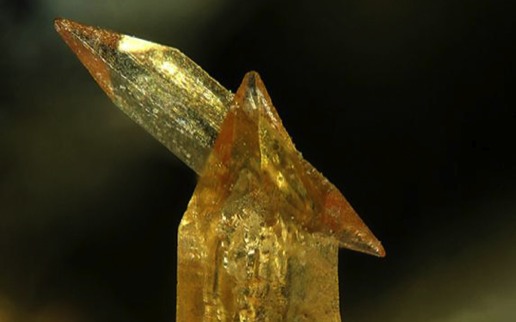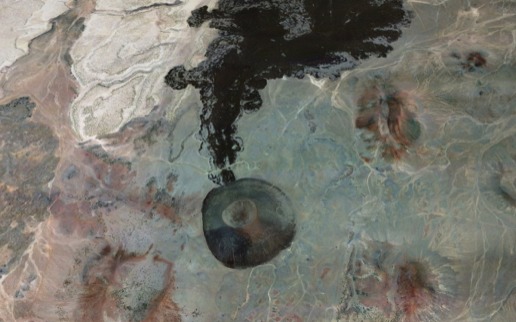⬆ Preliminary laser ablation double dating – (U-Th)/He and U/Pb – results for Fish Canyon zircon (NG3L and University of California – Santa Cruz)
The Noble Gas Geochronology and Geochemistry Laboratories (NG3L) at Arizona State were built to enable a broad range of noble gas geochemistry studies.Descriptions of many of our "applied" efforts in this realm are accessible the Tectonics and Planetary Science & Exploration tabs above, but some of our work is best described as basic research on noble gas kinetics and the development of new (or improved) protocols for geochronology and thermochronology.
Active Projects
Detrital Zircon (U-Th)/He and U/Pb Dating by Laser Ablation
Detrital zircon populations in active drainage systems and ancient clastic deposits can provide valuable information regarding sediment provenance as well as source region landscape and thermal evolution. Thermochronologic and geochronologic techniques are frequently applied in detrital zircon studies, but the most effective use of these techniques involves dating individual crystals with two or more isotopic chronometers. In collaboration with others (most recently Jeremy Hourigan of the University of California – Santa Cruz), group members have developed and are now fine-tuning a novel technique for rapid laser ablation (U-Th)/He and U/Pb dating of zircon crystals at the subgrain scale.
Publications
Tripathy-Lang, A. K., B. D. Monteleone, M. C. van Soest, and K. V. Hodges (2013), Laser (U-Th)/He thermochronology of detrital zircons as a tool for studying surface processes in modern catchments, Journal of Geophysical Research - Earth Surface, 118, 1333-1341.

Helium Diffusion in Accessory Phases
The KVH group has a history of studies of noble gas (particularly helium) diffusion in a variety of minerals. We undertake bulk diffusion experiments by controlled heating of single crystals in a furnace heated by either xenon bulb of infrared laser. Our capacity for ArF excimer laser depth profiling of experimental charges also permits us to evaluate the extent of crystallographically controlled variations in diffusivity.
Publications
Boyce, J. W., Hodges, K. V., Olszewski, W. J., and Jercinovic, M. J., 2005, He diffusion in monazite: Implications for (U-Th)/He thermochronometry: Geochemistry Geophysics Geosystems, v. 6, p. doi:10.1029/2005GC001058.
van Soest, M. C., Monteleone, B. D., Hodges, K. V., and Boyce, J. W., 2011, Laser depth profiling studies of helium diffusion in Durango fluorapatite: Geochimica et Cosmochimica Acta, v. 75, p. 2409-2419.
van Soest, M. C., Monteleone, B. D., Hodges, K. V., and Boyce, J. W., 2011, Laser depth profiling studies of helium diffusion in Durango fluorapatite: Geochimica et Cosmochimica Acta, v. 75, p. 2409-2419.

Ne diffusion and the (U-Th)/Ne Thermochronometer
In a 2006 Earth and Planetary Science Letters paper, Cécile Gautheron and colleagues noted that alpha particles from U and Th decay interact with 18O to produce 21Ne and envisioned the potential for a (U-Th)/Ne thermochronometer. Practical use of this technique requires a knowledge of the diffusivity of 21Ne in accessory minerals. We are conducting such studies on proton-irradiated zircon and titanite. (Proton irradiation produces a high concentration of synthetic 21Ne for diffusive-loss experiments.) Gautheron and colleagues initially suggested a (U-Th)/Ne closure temperature for zircon of 400 ± 50 ˚C based on test applications of the chronometer on a sample from Gold Butte, NV, for which a cooling history was constrained independently by other geochronometers and thermochronometers. Our laboratory diffusion experiments for both zircon and titanite suggest somewhat lower (U-Th)/Ne closure temperatures for geochronological cooling rates.

Dating Young Volcanic Deposits Through (U-Th)/He Thermochronometry of Intercalated Sediments
Young volcanic units – particularly aphyric basalts – are notoriously difficult to date accurately and precisely using traditional approaches such as 40Ar/39Ar geochronology. We have pioneered a new method of young volcanic geochronology for flows that were emplaced over fluvial deposits. Many such deposits contain detrital apatite and zircon, and the (U-Th)/He systematics of such minerals adjacent to the flow base can be reset as a consequence of contact metamorphism. We first successfully applied this method to Pliocene samples from the Taos Plateau in New Mexico, and undergraduate honors candidate Sarah Cronk is now applying it to Pleistocene flow sequences of the San Francisco volcanic field in northern Arizona.
Publication
Cooper, F. J., van Soest, M. C., and Hodges, K. V., 2011, Detrital zircon and apatite (U-Th)/He geochronology of intercalated baked sediments: A new approach to dating young basalt flows: Geochemistry Geophysics Geosystems, v. 12, p. doi: Q07003 07010.01029/02011gc003650.
